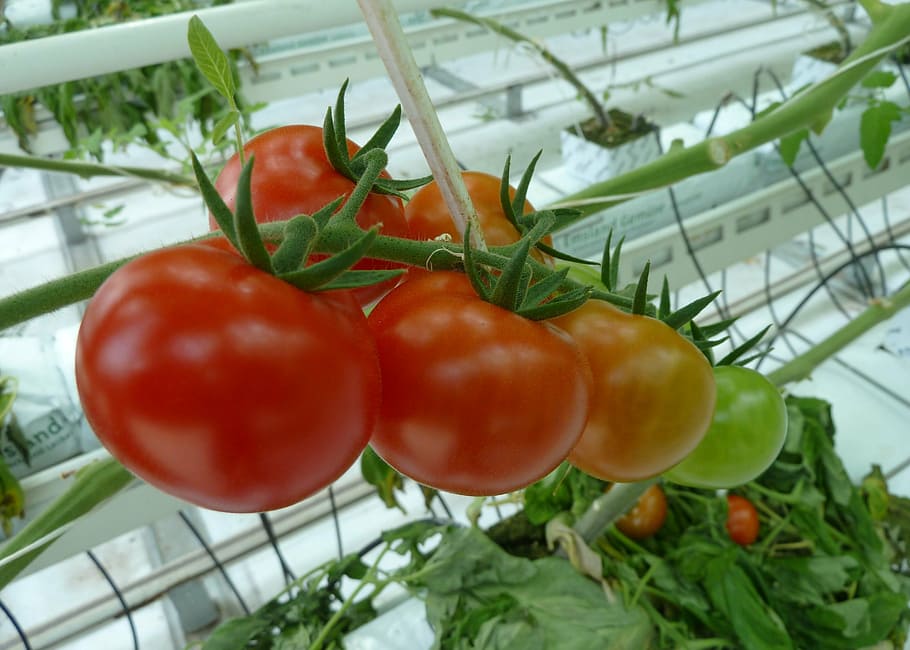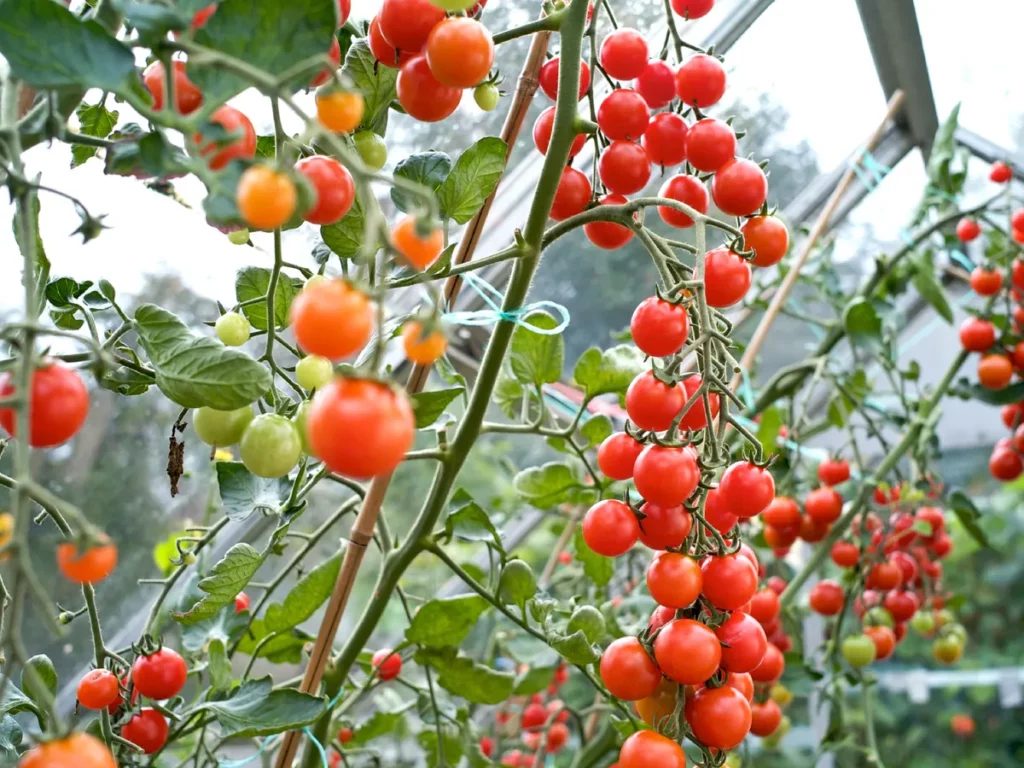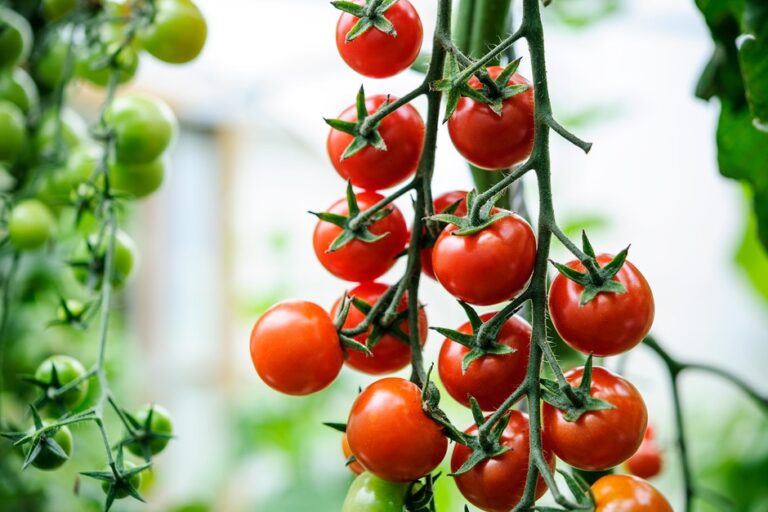When I walked into my greenhouse one sunny morning in early summer, I was greeted by the lush, green world inside. My tomato plants stood tall and healthy, a testament to the care I had given them. But in the midst of this thriving garden, I faced a challenge – I needed to string up my beloved tomato vines.
Stringing tomatoes in a greenhouse might sound like a simple task, but it’s a vital skill. It turns a wild tangle of vines into an organized and efficient garden. Whether you’re an experienced gardener looking to boost your tomato harvest or a beginner excited about greenhouse gardening, I’m here to guide you through the process.
To string tomatoes for optimal growth follow these quick guides:
- Choose a support system like stakes or trellises.
- Plant tomatoes with proper spacing.
- Install supports before plants grow too large.
- Monitor plant growth for suckers (lateral branches).
- Use soft garden twine to tie the main stem to the support structure.
- Spiral the stem around the string as it grows, pruning suckers.
- Regularly check for new suckers and continue stringing and pruning for healthy, upright growth and better fruit production.
What Are the Essential Materials Needed for Stringing Tomatoes?

When embarking on the journey to string tomatoes for optimal growth, it’s essential to gather the right materials that will set the foundation for a successful and thriving tomato crop.
List of Required Materials:
- Soft garden twine or nylon string: This serves as the primary material for stringing tomatoes.
- Tomato plants: Choose healthy seedlings or young plants for transplanting.
- Support structures (e.g., stakes, trellises, cages): These provide the framework for supporting the tomato plants.
- Pruning shears or scissors: Essential for trimming excess growth and removing suckers.
Explanation of Their Significance:
Soft garden twine or nylon string is used to support and guide the main stem of the tomato plant. It helps prevent the plant from falling over, which can lead to damage and reduce sunlight exposure.
In addition, tomato plants should be healthy and free from diseases to ensure optimal growth and fruit production.
Support structures such as stakes, trellises, or cages are crucial for keeping the tomato plants upright and preventing them from sprawling on the ground. They also facilitate better air circulation and sunlight penetration, reducing the risk of disease.
Moreover, pruning shears or scissors are necessary for maintaining the tomato plant’s shape and removing suckers. Pruning ensures that the plant channels its energy into growing vertically and producing fruit instead of excessive foliage.
How to Select the Ideal Support System for Tomatoes?
Choosing the perfect support system for your tomato plants is a crucial decision in ensuring their growth and productivity flourish.
Options:
- Stakes: Wooden or metal stakes are inserted into the ground, and tomato plants are tied to them as they grow. This option is suitable for smaller tomato varieties or determinate varieties that don’t grow very tall.
- Trellises: Trellises are vertical structures with horizontal bars or strings that provide support for tomato vines to climb. They are ideal for indeterminate tomato varieties that can grow tall.
- Cages: Tomato cages are wire structures that encircle the plant, providing support as it grows. They are particularly useful for bushy determinate varieties.
Factors Influencing the Choice:
- Tomato variety: The choice of support system depends on whether you are growing determinate or indeterminate tomato varieties. Indeterminate varieties require taller supports like trellises, while determinate varieties are better suited to cages or stakes.
- Available space: Consider the space in your garden. Trellises and stakes save horizontal space by encouraging vertical growth, while cages may require more room.
- Personal preference: Some gardeners prefer the aesthetics of one support system over another. Choose the one that aligns with your gardening style and goals.
What Are the Best Practices for Planting Tomatoes?
When it comes to planting tomatoes, mastering a few key practices can make all the difference in nurturing robust and fruitful plants.
Proper Spacing and Planting Guidelines:
Proper spacing is crucial to ensure that tomato plants receive adequate sunlight and air circulation. Follow the recommended spacing guidelines for the specific tomato variety you are growing. This information can typically be found on seed packets or plant tags.
Moreover, adequate spacing between plants prevents overcrowding, which can lead to disease and reduced fruit production.
Importance of Preparing Support Structures in Advance:
Installing support structures before planting ensures that they are in place as the tomato plants grow. Waiting until the plants are too large can risk damaging the plants during installation.
Furthermore, support structures are essential for training the tomato plants to grow vertically, reducing the risk of disease, and promoting healthier growth.
How to Effectively Monitor Tomato Growth?
Keeping a watchful eye on the progress of your tomato plants is a vital aspect of successful cultivation.
Identifying Suckers (Lateral Branches):
Suckers, also known as axillary shoots, emerge from the leaf axils, which are the points where a leaf branch meets the main stem of the tomato plant.
Furthermore, they often appear as small, green shoots and can develop into secondary stems if not pruned.
Suckers can be identified by their location between the main stem and leaves, distinguishing them from the main stem’s upward growth.
Understanding Their Impact on Plant Growth:
Suckers can divert the plant’s energy away from the main stem, resulting in a bushier growth habit.
However, if left unmanaged, excessive suckers can lead to overcrowding and reduced air circulation, making the plant more susceptible to diseases such as blight.
Pruning suckers redirects the plant’s resources into the primary stem, encouraging vertical growth and more efficient fruit production.
What Are the Key Steps to Stringing Tomatoes?
As you embark on the journey of stringing tomatoes for optimal growth, there are key steps to follow in this essential technique for supporting your tomato plants.
Initiating Stringing When the Plant is 6-8 Inches Tall:
Starting the stringing process at this height allows for early support, preventing the plant from bending or falling over due to its weight. Moreover, it’s also an appropriate time to begin because the main stem is sturdy enough to withstand tying without damage.
Tying the Main Stem to the Support Structure:
Carefully secure one end of the soft garden twine or nylon string to the support structure near the base of the tomato plant. Moreover, gently guide the main stem upwards as it grows, securing it to the string at regular intervals.
Tying the stem provides stability and encourages upright growth, preventing it from bending or breaking.
Spiral Guidance and Stem Twisting Technique:
As the tomato plant continues to grow, spiral the main stem around the string in a clockwise or counterclockwise direction, depending on your preference.
Moreover, this technique ensures even support and allows the plant to naturally grow upwards without straining.
Pruning Suckers to Redirect Energy:
Pruning suckers involves removing these lateral branches to focus the plant’s energy on the main stem and fruit production.
Moreover, use pruning shears or pinch off suckers when they are small, typically around 1-2 inches long. By pruning, you prevent overcrowding and promote healthier fruit development on the main stem.
How Can You Ensure Proper Maintenance of Tomatoes?

The essential steps and practices that will help you keep your tomatoes healthy and thriving throughout their growth cycle.
Regular Checks for New Suckers:
Continue to monitor the tomato plant for the emergence of new suckers throughout the growing season.
Regular checks ensure that you catch and prune suckers while they are still small and manageable.
Ongoing Stringing and Pruning:
As the plant grows, add more strings as needed, spaced about 6-8 inches apart along the main stem.
Moreover, maintain the stringing and pruning routine to keep the plant upright and ensure it doesn’t become too bushy.
Ensuring Upright Growth, Air Circulation, and Sunlight Exposure:
The primary goal of maintaining tomatoes is to encourage upright growth to prevent disease and support fruit production.
In addition, proper stringing and pruning also facilitate better air circulation between the leaves, reducing the risk of fungal diseases. Ensuring that the main stem receives adequate sunlight exposure is essential for photosynthesis and optimal fruit ripening.
FAQ’s
How do you set up a greenhouse for tomatoes?
Prepare the greenhouse location, ensuring good sunlight and drainage. Install appropriate shelving or benches. Provide proper ventilation, temperature control, and support structures like trellises or strings for tomato plants.
How do you wire tomato plants?
Use soft garden twine or tomato clips to gently secure tomato plants to support structures, ensuring they grow upright and receive proper airflow and sunlight.
What is the best string for tying up tomatoes?
Soft garden twine or nylon string is ideal for tying up tomatoes. It’s gentle on plants and provides adequate support.
How do you keep tomatoes from falling over?
Use support systems like stakes, trellises, or strings to keep tomato plants upright. Prune suckers and maintain proper spacing to reduce overcrowding.
What is the best greenhouse design for tomatoes?
A greenhouse with ample height, good ventilation, and sufficient sunlight penetration is ideal. Consider a high tunnel or hoop house design with adjustable side vents.
Is a greenhouse too hot for tomatoes?
Greenhouses can become too hot for tomatoes in hot weather. Proper ventilation, shading, and temperature control are essential to prevent overheating.
Do tomatoes get too hot in a greenhouse?
Yes, without adequate ventilation and temperature control, tomatoes can become overheated in a greenhouse. It’s crucial to monitor and manage greenhouse conditions to prevent this.
Conclusion
In summary, I’ve learned that stringing tomatoes is a fundamental practice in tomato cultivation, and it plays a pivotal role in ensuring the optimal growth and productivity of these beloved garden plants. From understanding the materials required, such as soft garden twine and support structures, to choosing the right support system based on factors like tomato variety and available space, each step is integral to success.
Furthermore, monitoring tomato growth involves the critical task of identifying and managing suckers, which can greatly impact the overall health of the plant. Stringing tomatoes, initiated when the plant reaches a height of 6-8 inches, involves tying the main stem to a support structure, utilizing a spiral technique that promotes both stability and vertical growth.

